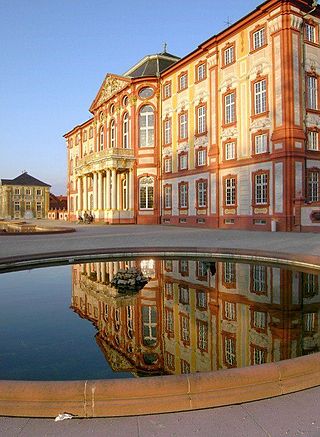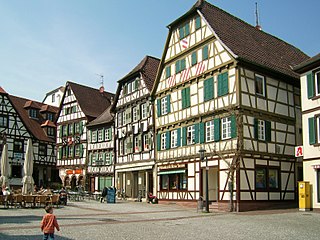Related Research Articles

Bruchsal is a city at the western edge of the Kraichgau, approximately 20 km northeast of Karlsruhe in the state of Baden-Württemberg, Germany. It is located on Bertha Benz Memorial Route.

Josef Breuer was an Austrian physician who made discoveries in neurophysiology, and whose work during the 1880s with his patient Bertha Pappenheim, known as Anna O., developed the talking cure which was used as the basis of psychoanalysis as developed by his protégé Sigmund Freud.

M. M. Warburg & CO KGaA is a German private bank, based in Hamburg. A family-owned bank, it was founded in 1798 by brothers Moses Marcus Warburg and Gerson Warburg, two members of the Warburg family. The bank was Aryanized under the Nazis. The Warburg family still owns the bank, continuing a more than 200-year legacy of private ownership.

Bretten is a town in the state of Baden-Württemberg, Germany. It is located on Bertha Benz Memorial Route.

Studies on Hysteria is an 1895 book by Sigmund Freud, the founder of psychoanalysis, and the physician Josef Breuer. It consists of a joint introductory paper ; followed by five individual studies of hysterics – Breuer's famous case of Anna O., seminal for the development of psychoanalysis, and four more by Freud— including his evaluation of Emmy von N— and finishing with a theoretical essay by Breuer and a more practice-oriented one on therapy by Freud.

Bertha Pappenheim was an Austrian-Jewish feminist, a social pioneer, and the founder of the Jewish Women's Association. Under the pseudonym Anna O., she was also one of Josef Breuer's best-documented patients because of Sigmund Freud's writing on Breuer's case.

When Nietzsche Wept is a 2007 American art drama film directed by Pinchas Perry and starring Armand Assante, Ben Cross and Katheryn Winnick. It is based on the novel of the same name by Irvin D. Yalom. It was filmed in Bulgaria.

Herbert Wetterauer is a German painter, sculptor and author. He is known for his paintings in ink and life-sized figures made of paperboard, for which he developed his own technique.
Erich Schelling was a German architect.

Kurt Martin was a German art historian. His career began in 1927 as curator of the Baden State Museum Karlsruhe. From 1934 to 1956, he was director of the Staatlichen Kunsthalle Karlsruhe. In 1940 he was appointed Head of the Municipal Museums of Strasbourg as well as Chief Commissioner of the Alsatian Museums. In 1956 he became Director of the Karlsruher Kunstakademie, and in 1957 General Director of the Bayerischen Staatsgemäldesammlungen. He was also a professor of art history.
Fritz Nathan was a German-Swiss gallery owner and art dealer.

Paul Robert Ernst von Mendelssohn-Bartholdy was a German Jewish banker and art collector. The persecution of his family under the Nazis has resulted in numerous lawsuits for restitution.
Bertha Regina Sander was a German interior designer persecuted by the Nazis because Jewish. She left Germany in 1936 and lived in England ever since. Bertha Sander was one of the few women who had already worked as a (garden) architect, interior designer or craftswoman before 1945.

Heinrich Arnhold, in full Heinrich Gustav Arnhold was a German banker, collector, patron and esperantist.
Bankhaus Adolph Meyer was a private bank, and the oldest in Hanover, Germany. It played a prominent role in the industrialization of Lower Saxony, particularly in the cotton and coal and steel industries, especially since the time of the Kingdom of Hanover. During the Nazi era, it was "Aryanized". It is now located on Schillerstraße at the corner of Rosenstraße in Hannover's Mitte district.

Hannah Karminski was a German educator and an important contributor to the Jewish Women's League and the Reich Association of Jews in Germany. She helped many persecuted people to emigrate and was murdered in the Holocaust.
Helene Hecht was a German Jewish art collector, salonnière and patron of the arts.
Martin Aufhäuser was a German banker who ran and grew private bank Bankhaus H. Aufhäuse. During the Nazi era the bank was Aryanized and Aufhäuser escaped to the United States.

Bankhaus Veit L. Homburger in Karlsruhe was founded in 1854 by the Jewish citizen Veit Löw Homburger. The bank was liquidated by the National Socialists in 1939, but the bank building at Karlstraße 11 was preserved.
Paul Schüler (1876-1942) was a German Jewish banker and art collector murdered in the Holocaust.
References
- ↑ Bankhaus Veit Löw Homburger. In: Datenbank der Kulturdenkmale. Stadt Karlsruhe, retrieved 5 September 2022.
- ↑ Borch-Jacobsen, Mikkel (2011). Les Patients de Freud. Destins. Éditions Sciences Humaines.
- ↑ "Bertha Pappenheim (1859-1936) | Psychology Today". www.psychologytoday.com. Retrieved 2023-11-02.
In 1953, Ernest Jones revealed the identity of "Anna O." in the first volume of his Freud biography, adding for good measure the story of Bertha Pappenheim's alleged hysterical pregnancy, which Freud had told him. Bertha Pappenheim's relatives were shocked. On June 20, 1954, Aufbau, the newspaper of the German-speaking immigrants in New York, published a letter from Paul Homburger, Bertha Pappenheim's executor
- ↑ "In re Holocaust Victim Assets LitigationCase No. CV96-4849Certified Award to Claimant [REDACTED]in re Account of Veit L. HomburgerClaim Number: 224038/CH" (PDF). Claims Resolution Trust.
- ↑ "Auch bei Karlsruher Familien schlummert noch NS-Raubgut". Badische Neueste Nachrichten (in German). 2023-01-27. Retrieved 2023-11-02.
- ↑ "Homburger, Paul Philipp". De Gruyter. Retrieved 2023-11-02.
- ↑ "Provenienzforscherin klärt Herkunft auf". www.lootedart.com. Retrieved 2023-11-02.
- ↑ "Aktuelle Nachrichten aus der Landeskunde". www.zum.de. Retrieved 2023-11-02.
- ↑ "Akademiestr. 36, Karlstr. 11 (Flst. 331)". web1.karlsruhe.de (in German). Retrieved 2023-11-02.